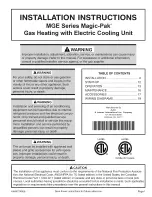
35
GI-IM048En-1013
VENT / AIR INLET SIZE
MINIMUM EXISTING VENT / CHASE SIZE
2” (5 cm)
4” (10 cm)
3” (7.6 cm)
5” (13 cm)
4” (10 cm)
7” (18 cm)
Table 9 – Minimum Vent / Chase Sizing
VENTING AS A CHASE
When venting as a chase, follow all instructions included in Part 5 – Venting of this
manual, as well as the previous Concentric Venting section. See Figure 16 for
chase venting demonstration.
NOTES:
A. For every 1” (2.5 cm) of overhang, the exhaust vent must be located 1” (2.5 cm) vertical
below overhang (overhang means top of building structure and not two adjacent walls [corner
of building]).
B. Typical installations require 12” (30 cm) minimum separation between bottom of exhaust
outlet and top of air intake.
C. Maintain 12” (30 cm) minimum clearance above highest anticipated snow level or grade
(whichever is greater).
D. Minimum 12” (30 cm) between vents when installing multiple vents.
E. 12” (30 cm) minimum beyond air intake.
F. Maintain 12” (30 cm) minimum clearance above highest anticipated snow level or grade
(whichever is greater).
3. INDOOR COMBUSTION AIR INSTALLATION IN CONFINED OR
UNCONFINED SPACE
This heater requires fresh, uncontaminated air for safe operation and must be
installed in a mechanical room where there is adequate combustion and ventilating
air.
NOTE: To prevent combustion air contamination, see Table 1
: Contaminant
Table.
Combustion air from the indoor space can be used if the space has adequate area
or when air is provided through a duct or louver to supply sufficient combustion air
based on the water heater input.
Never obstruct the supply of combustion air to
the water heater.
If the water heater is installed in areas where indoor air is
contaminated (see Figure 17) it is imperative that the water heater be installed as
direct vent so that all combustion air is taken directly from the outdoors into the
water heater intake connection.
Unconfined space
is space with volume greater than 50 cubic feet per 1,000
Btu/hour (4.8 cubic meters per kW) of the total input rating of all fuel-burning
appliances installed in that space. Rooms connected directly to this space, through
openings not furnished with doors, are considered part of the space.
Confined space
is space with volume less than 50 cubic feet per 1,000 Btu/hour
(4.8 cubic meters per kW) of the total input rating of all fuel-burning appliances
installed in that space. Rooms connected directly to this space, through openings
not furnished with doors, are considered part of the space.
When drawing combustion air from inside a conventionally constructed building to a
confined space, such space should be provided with two (2) permanent openings:
one located 6” (15 cm) below the space ceiling, the other 6” (15 cm) above the
space floor. Each opening should have a free area of one square inch per 1,000
Btu/hr (22 cm
2
/kW) of the total input of all appliances in the space, but not less than
100 square inches (645 cm
2
).
If the confined space is within a building of tight construction, air for combustion
must be obtained from the outdoors as outlined in the Venting section of this
manual. See
Figure 18
.
Figure 17: LP-325-X
Figure 16: Venting as a Chase
LP
Содержание UGC120S-100
Страница 36: ...36 GI IM048En 1013 Figure 18 LP LP ...
Страница 39: ...39 GI IM048En 1013 D INTERNAL WIRING DIAGRAM Figure 21 Wiring Diagram LP ...
Страница 40: ...40 GI IM048En 1013 Figure 22 LP 179 L LP ...
Страница 49: ...49 GI IM048En 1013 Figure 26 LP 179 J LP ...
Страница 50: ...50 GI IM048En 1013 Figure 27 LP 179 H LP ...
Страница 52: ...52 GI IM048En 1013 MAINTENANCE NOTES ...
















































